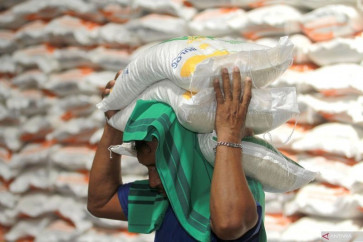Popular Reads
Top Results
Can't find what you're looking for?
View all search resultsPopular Reads
Top Results
Can't find what you're looking for?
View all search resultsSoul: ‘Pis bolong’ - “An ancient Chinese coin that is still going strong”
The close connection between Bali and China dates back many centuries
Change text size
Gift Premium Articles
to Anyone
The close connection between Bali and China dates back many centuries. One demonstration of this is marked by the use of old Chinese coins with square holes in the center, known as pis bolong in the Balinese language and uang kepeng in Indonesian.
The story behind the use of these ancient coins goes back to the early 11th century when the king of Bali, Sri Jaya Pangus, decided to marry a beautiful Chinese princess, Tang Ci Keng, who was from the Tang dynasty.

The marital tie between the Balinese king and the Chinese princess caused the cultures to blend and the traditions of both sides to be adopted. The Chinese influence can still be vividly seen in many aspects of Balinese life, including grand architectural styles, textile colors and designs, dance and drama.
After his marriage, the king decided to use these Chinese coins for many purposes, especially religious rituals. Since then, and up to the present day, these coins have been part of many Hindu rituals.
Many believe that the coins possess divine power or energy that brings luck and happiness to the owner.

In the past, the Chinese coins were used as a currency because of their high value, but today are rarely found. Despite this, the Balinese continue to seek authentic, as well as cheaper replicas of, old Chinese coins for religious purposes.
In 2002, the provincial government decided to support a small-scale home industry in Kamasan village in Klungkung to revive pis bolong production.
Local artisans are now producing pis bolong in five different metals, known as panca datu or the five strengths of life — iron, silver, copper, gold and bronze. These pis bolong continue to be regarded as sacred items.

Prior to making the coins, the artisans have to perform a series of prayers and rituals to bless the process and final product with spiritual prowess. The rituals usually take place at Pura Besakih, Bali’s most sacred place of worship.
Today, pis bolong production is flourishing in Kamasan and the artisans produce around 7,000 coins every day, many of which are sold for various religious purposes.
The coins are also used to decorate highly artistic objects, such as statues of Hindu gods and goddesses and holy figures. They are also used to make pendants marked with holy Hindu characters.
Hundreds of years since their introduction to the island, these old Chinese coins remain a source of harmony and happiness for many Balinese people.










